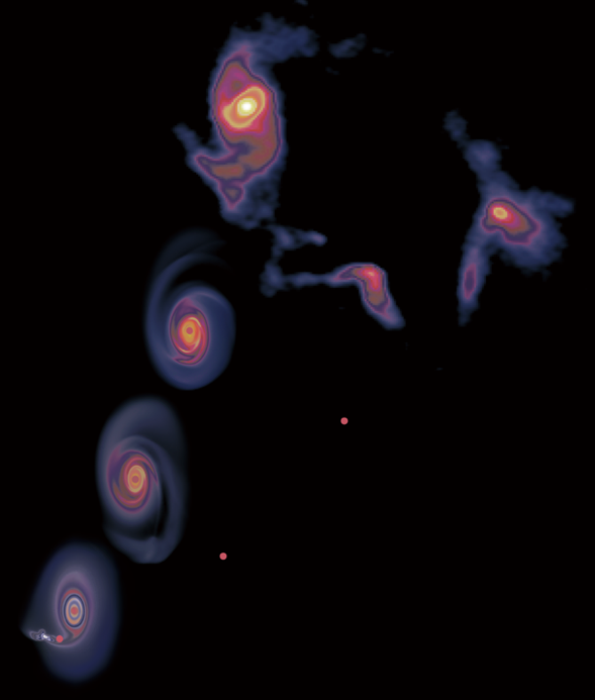Dr. LU Xing, an associate researcher from the Shanghai Astronomical Observatory (SHAO) of the Chinese Academy of Sciences, along with collaborators from Yunnan University, the Harvard-Smithsonian Center for Astrophysics, and the Max Planck Institute, have used high-resolution observational data from the Atacama Large Millimeter/submillimeter Array (ALMA) to discover a massive protostellar disk in the Galactic Center and determine how its spiral arms were formed.

Credit: SHAO
Dr. LU Xing, an associate researcher from the Shanghai Astronomical Observatory (SHAO) of the Chinese Academy of Sciences, along with collaborators from Yunnan University, the Harvard-Smithsonian Center for Astrophysics, and the Max Planck Institute, have used high-resolution observational data from the Atacama Large Millimeter/submillimeter Array (ALMA) to discover a massive protostellar disk in the Galactic Center and determine how its spiral arms were formed.
The group’s research shows that this disk was perturbed by close encounter with a nearby object, thus leading to the formation of the spiral arms. This finding demonstrates that the formation of massive stars may be similar to that of lower-mass stars, through accretion disks and flybys.
The results were published in Nature Astronomy on May 30.
During the formation of stars, accretion disks arise around newborn stars. These accretion disks, also known as “protostellar disks,” are an essential component in star formation. Accretion disks continuously feed gas into protostars from the environment. In this sense, they are stellar cradles where stars are born and raised.
For massive protostars, especially early O-type ones of more than 30 solar masses, however, the role of accretion disks in their formation has not been clear.
At a distance of about 26,000 light years from Earth, the Galactic Center is a unique and important star-forming environment. Besides the supermassive black hole Sgr A*, the Galactic Center contains a huge reservoir of dense molecular gas, mostly in the form of molecular hydrogen (H2), which is the raw material for star formation. The gas starts to form stars once gravitational collapse is initiated.
However, the environment in the Galactic Center is unique, with strong turbulence and strong magnetic fields as well as tidal forces from Sgr A*, all of which substantially affect star formation in this region.
Since the distance between the Galactic Center and Earth is huge and complicated foreground contaminations exist, direct observations of star-forming regions around the Galactic Center have been challenging.
The research team led by Dr. LU used ALMA’s long baseline observations to achieve a resolution of 40 milliarcseconds. To get an idea how fine that resolution is, it would allow an observer in Shanghai to easily spot a football in Beijing.
With these high-resolution, high-sensitivity ALMA observations, the researchers discovered an accretion disk in the Galactic Center. The disk has a diameter of about 4,000 astronomical units and surrounds a forming, early O-type star with a mass about 32 times that of the Sun. This system is among the most massive protostars with accretion disks and represents the first direct imaging of a protostellar disk in the Galactic Center.
The discovery suggests that massive early-O type stars go through a formation phase involving accretion disks, and this conclusion is valid for the unique environment of the Galactic Center.
What is more interesting is that the disk clearly displays two spiral arms. Such arms are often found in spiral galaxies but are rarely seen in protostellar disks. In general, spiral arms emerge in accretion disks due to fragmentation induced by gravitational instability. However, the disk discovered in this research is hot and turbulent, thus making it able to balance its own gravity.
In trying to explain this phenomenon, the researchers proposed an alternate explanation—that the spirals were induced by external perturbation. The researchers proposed this explanation after detecting an object of about three solar masses—possibly the source of the external perturbation—several thousand astronomical units away from the disk.
To verify this proposition, the researchers calculated several dozen possible orbits of this object. They found that only one of these orbits could perturb the disk to the observed level. They subsequently carried out a numerical simulation on the high-performance supercomputing platform of the Shanghai Astronomical Observatory to trace the trajectory of the intruding object. The scientists were able to successfully reproduce the entire history of the object flying by the disk more than 10,000 years ago, when it would have stirred up spirals in the disk.
“The nice match among analytical calculations, the numerical simulation, and the ALMA observations provides robust evidence that the spiral arms in the disk are relics of the flyby of the intruding object,” said Dr. LU.
This finding clearly demonstrates that accretion disks at early evolutionary stages of star formation are subject to frequent dynamic processes such as flybys and these processes can substantially influence the formation of stars and planets.
Interestingly, flybys may have occurred in our own solar system too: A binary stellar system known as Scholz’s Star flew by the solar system about 70,000 years ago, probably penetrating through the Oort cloud and sending comets to the inner solar system.
The current study suggests that for more massive stars, especially in the high-stellar-density environment around the Galactic Center, such flybys should also be frequent. “The formation of this massive protostar is similar to its lower-mass cousins like the Sun, with accretion disks and flyby events involved. Although stellar masses are different, certain physical mechanisms in star formation could be the same. This provides important clues to solving the mystery of massive star formation,” said Dr. LU.
Journal
Nature Astronomy
DOI
10.1038/s41550-022-01681-4
Article Title
A massive Keplerian protostellar disk with flyby-induced spirals in the Central Molecular Zone
Article Publication Date
30-May-2022




